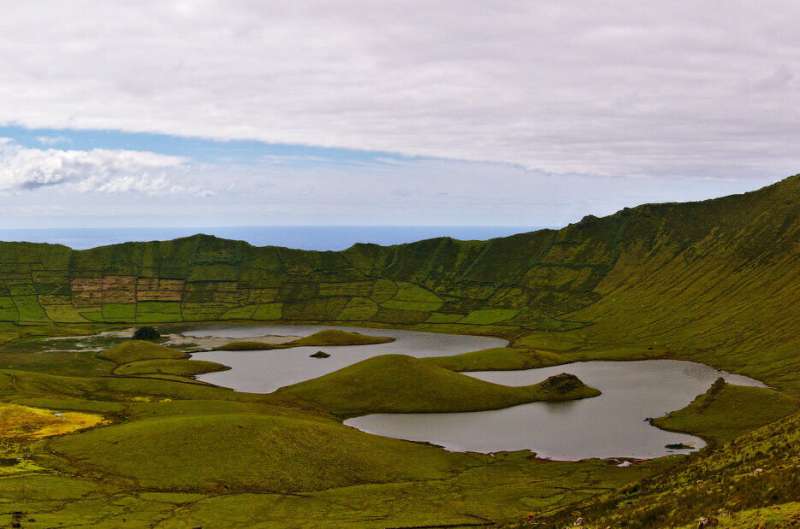Researchers find 1st evidence of multiple people buried in Tomb of Nestor's Cup

The Tomb of Nestor's Cup on the Italian island of Ischia is named for a wine cup featuring one of the earliest surviving inscriptions in the Greek language. Photo by Gigante et al./PLOS ONE
Oct. 6 (UPI) -- An analysis of burnt bone fragments in the 8th century Tomb of Nestor's Cup has revealed that the cremains of not one, but at least three humans were buried at the site in Italy, scientists announced Wednesday.
The tomb, discovered in 1954 and on the island of modern-day Ischia, was long believed to contain the cremains of a young person about 10 years old to 14 years old at death. The archaeological site on what was previously called Pithekoussai, was notable because of a broken wine cup that featured one of the earliest surviving examples of Greek writing.
It read, in translation: "I am Nestor's cup, good to drink from. Whoever drinks this cup empty, straightaway desire for beautiful-crowned Aphrodite will seize him."
Researchers at the University of Padua, Italy, conducted a microscopic analysis of the remains to try to answer the question of who was buried with the famed cup.
"A vast body of literature has attempted to explain the unique association between the exceptionality of the grave good complex, the symposiac and erotic evocation of the Nestor's Cup inscription with the young age of the individual buried with it," the research article, published Wednesday in PLOS ONE, read.
The researchers studied 195 burnt bone fragments, determining at least 45 belonged to animals, including goats and possibly dogs. The animals were likely buried with the human remains to act as food or companions.
Of the 130 human bone fragments, the scientists were able to identify characteristics of varying life stages, indicating at least three individuals' cremains were buried in the tomb.
The article said the discovery raises even more questions about the tomb. Researchers have been unable to determine the identity of those buried in the tomb, their age at death, how they died or why they were buried with the cup.
"Our research rewrites the history and the previous archaeological interpretation of the Tomb, throwing new light on funeral practices, culture and society of the Greek immigrants in the ancient West Mediterranean," the authors, led by Melania Gigante, said in a statement.
"We are sure that our study can be a new methodological step toward the reconstruction of the life-history of people in ancient times, even in case of poor preservation and/or complexity of the skeletal assemblage," they said.
"A vast body of literature has attempted to explain the unique association between the exceptionality of the grave good complex, the symposiac and erotic evocation of the Nestor's Cup inscription with the young age of the individual buried with it," the research article, published Wednesday in PLOS ONE, read.
The researchers studied 195 burnt bone fragments, determining at least 45 belonged to animals, including goats and possibly dogs. The animals were likely buried with the human remains to act as food or companions.
Of the 130 human bone fragments, the scientists were able to identify characteristics of varying life stages, indicating at least three individuals' cremains were buried in the tomb.
The article said the discovery raises even more questions about the tomb. Researchers have been unable to determine the identity of those buried in the tomb, their age at death, how they died or why they were buried with the cup.
"Our research rewrites the history and the previous archaeological interpretation of the Tomb, throwing new light on funeral practices, culture and society of the Greek immigrants in the ancient West Mediterranean," the authors, led by Melania Gigante, said in a statement.
"We are sure that our study can be a new methodological step toward the reconstruction of the life-history of people in ancient times, even in case of poor preservation and/or complexity of the skeletal assemblage," they said.
Evidence of people on the Azores archipelago 700 years earlier than thought

An international team of researchers has found evidence that people lived on islands in the Azores archipelago approximately 700 years earlier than prior evidence has shown. In their paper, published in Proceedings of the National Academy of Sciences, the group describes their study of sediment cores taken from lakes on some of the islands in the archipelago.
Due to the absence of other evidence, historians have believed that people first arrived in the Azores in 1427, when Portuguese sailor Diogo de Silves landed on Santa Maria Island. Soon thereafter, others from Portugal arrived and made the archipelago their home. In this new effort, the researchers found evidence that humans were living on some of the islands in the Azores approximately 700 years earlier.
Looking to learn more about the history of the Azores, the researchers began collecting sediment samples from several of the lakes on the islands and studying them to see what they might reveal. Sediment samples can serve as historical evidence because material in the air that falls to the surface of a lake and then to the lake bottom is covered over by new layers of sediment as time passes.
Analysis of the sediment cores showed an increase in 5-beta-stigmasterol in a core layer dated to a time between 700 CE and 850 CE, taken from Peixinho Lake. The compound is typically found in the feces of livestock, such as cows and sheep—neither of which lived in the Azores prior to the arrival of humans. They also saw upticks in charcoal particles (suggesting large fires had been burning) along with a dip in native tree pollens. The findings suggest someone had burned down forest to provide more land for livestock. The researchers found similar evidence in cores taken from Caldeirão Lake, which is on a different island, though it appeared approximately a century later. And they found evidence of non-native ryegrass in the sediment taken from a lake on a third island.

The findings present strong evidence of humans inhabiting the archipelago hundreds of years before the Portuguese arrived. The researchers theorize that they were likely Norse seafarers, noting their accomplishments in sailing up and down the coasts of many parts of Europe.Sediment cores from Dogger Littoral suggest Dogger Island survived ancient tsunami
More information: Pedro M. Raposeiro et al, Climate change facilitated the early colonization of the Azores Archipelago during medieval times, Proceedings of the National Academy of Sciences (2021). DOI: 10.1073/pnas.2108236118
Journal information: Proceedings of the National Academy of Sciences
© 2021 Science X Network
Acheulean Tool-Making Tradition May Have Persisted Until About 177,000 Years Ago Before Homo Sapiens Arrived
Acheulean technologies, the longest-lasting tool-making in prehistory, first appeared 1.75 million years ago in easter Africa and persisted until 1.2 million years ago in India. It is characterized by the production of large bifacial tools, such as cleavers and stone handaxes.
Phys.org reported that new research from scientists at Max Planck Institute for the Science of Human History re-examined an Acheulean site at the margins of the monsoon zone in the Thar Desert, India. They reveal that Acheulean populations must have persisted until 177,000 years ago, just before Homo sapiens arrived.

A photograph of the upper pre-historic archeological site at the Kariandusi Museum in Kenya. The photograph is of the extensive collection of Acheulean hand-axes excavated by Louis Leakey in 1928. The hand-axes are from the Lower Paleolithic era and are made from both obsidian and trachyte.
World's Youngest Acheulean Sites
In a paper titled "Constraining the Chronology and Ecology of Late Acheulean and Middle Palaeolithic Occupations at the Margins of the Monsoon" published in Scientific Reports, researchers reported the recent occupation of Acheulean populations in the site of Singi Talav up to 177,000 years ago.
It turns out that this is the youngest site of Acheulean populations in India. South Asia has been known before as the home of the world's youngest Acheulean sites, but this discovery opens a new understanding of the earliest expansions of Homo sapiens across Asia.
Singi Talav is located in a lakeside close to the modern town of Didwana at the monsoon zone of the Thar Desert, where multiple stone tools were discovered in the early 1980s. Since then, several Acheulean sites have been examined to determine the dates of Acheulean occupations in India. However, the techniques needed to accurately date the discoveries were inadequate at that time, so they remain poorly known.
Study lead author Dr. Jimbob Blinkhorn said that the lakeside site has ideal preservation conditions for an archaeological site, which allowed scientists to return after three decades since it was first excavated. They used modern methods to re-examine the site, such as luminescence methods and new approaches to date the Acheulean occupation.
These methods allowed them to determine the last time sediments were exposed to light to understand when ancient humans lived in the area and created the stone tools. They were also able to compare it to other sites across the region.
Studying the Ecology of an Acheulean Site in India
The Thar Desert is located at the western edge of the modern Indian monsoon system. According to Britannica, the subtropical climate in the desert resulted from persistent high pressure and the site's subsidence. The southwest monsoon winds bring rain during summer, but it tends to bypass the desert to the east.
As Phys.org reported, researchers believe that the summer monsoon system of that site may have allowed ancient humans to thrive, although it might have fluctuated significantly. Researchers examined phytoliths and soil geochemistry to reveal the site's ecology when Acheulean stone tools were made.
This is the first time that the ecology of an Acheulean site in India has been examined with modern techniques to reveal a broader character of the landscape where ancient humans might live.
They noted that their findings support evidence from across the region that the youngest Acheulean populations of the world are in India, which persisted until Homo sapiens appeared and expanded across Asia. The Thar Desert most likely became a key ecological frontier for Homo sapiens to expand their populations and meet other populations.
No comments:
Post a Comment